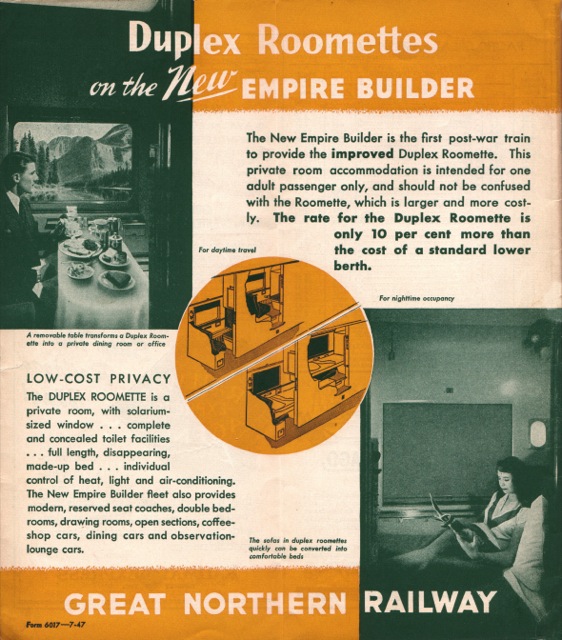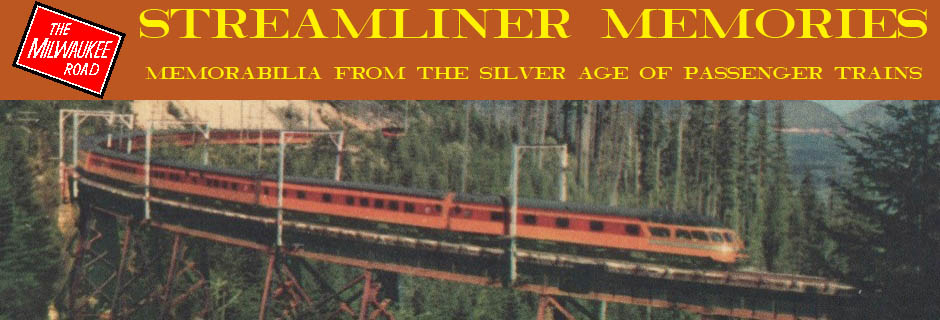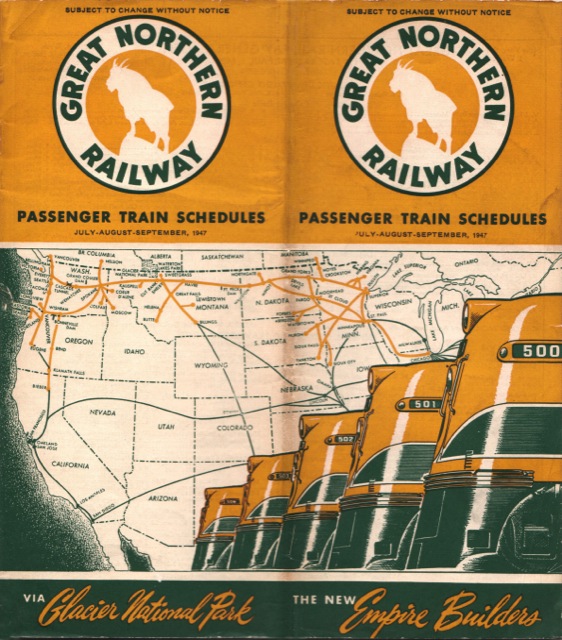The streamlined Empire Builder was introduced in February, 1947, so this is the first summer timetable featuring that train. A full 21 pages of this 44-page booklet are devoted to Great Northern trains (including connecting Burlington and SP&S trains), partly because 9 of those pages are used to present the Chicago-Seattle route of the Empire Builder and Oriental Limited in excruciating detail.
Click image to download a 29.4-MB PDF of this timetable.
A dozen more pages have more than 80 timetables for local trains, one of which (Wenatchee to Mansfield, WA) went only on Wednesdays and Sundays; another (Evansville to Elbow Lake, MN) only on Tuesdays; and other schedules were freight only. There are a few timetables for buses and one for the Lake Chelan (WA) Boat Company.

The back cover of the timetable advertises the duplex roomette, claiming “the New Empire Builder is the first post-war train to provide the improved Duplex Roomette.” Pullman first introduced duplex roomettes in 1942, but the 1947 versions are apparently “improved.” “This private room accommodation is intended for one passenger only,” says the ad, “and should not be confused with the Roomette, which is larger and more costly.” Roomettes, which were only slightly larger than duplex roomettes, would not be available on any Great Northern train until the 1951 Mid-Century Empire Builder.
Another ad in the timetable promises that, in addition to the streamlined Empire Builder, the GN will soon streamline its Seattle-Vancouver trains. The ad says these will be called “Puget Sounders,” but of course, they were actually called the Internationals. Other ads encourage passengers to stop off at Glacier Park; describe food and beverages sold by on-board “train salesmen” (“Meat sandwich . . . 20¢” or $2 today); promote GN’s “fast, dependable” freight service; and make passengers aware of a variety of other trains and services.
The rest of the booklet includes four pages of connecting train schedules; six pages of general information such as an index to every station mentioned in the timetables and a list of GN ticket agents; three pages describing the equipment on major GN trains; a two-page centerfold map of the Great Northern system and connections; and four pages providing fares on board GN trains.
Train travel wasn’t cheap in 1947. The round-trip coach fare from Chicago to Seattle or Portland was $76.20, which sounds reasonable but is nearly $800 in today’s money. This doesn’t include a 15 percent federal excise tax, which brings the total to $87.63 or more than $900 today. By comparison, summer coach fares on Amtrak today are under $600.
Sleeping car passengers had to pay a first-class fare, which was $114.25, nearly $1,200 in today’s money, plus a fare to the Pullman company that depended on the accommodation, starting at $13.90 each way for an upper berth rising to as much as $43.35 for a drawing room, plus tax. The total cost, including tax, for someone taking a duplex roomette round trip would be $177.15, or more than $1,800 today. Including the basic fares, a “Superliner roomette” on Amtrak today, which can fit two people, would cost about $1,486 round trip for one and $2,080 for two, and those prices include all meals in the diner.
The 1947 timetable also lists “intermediate-class” fares, which I presume were paid by people who wanted to ride in “tourist sleepers.” These were available on the Oriental Limited but not the streamlined Empire Builder and consisted of cars with 32 upper and lower berths, which meant passengers could expect to find the washrooms more crowded than in other sleeping cars. The round-trip fare, including the Pullman charge and tax, for someone willing to settle for an upper berth was $129, or around $1,350 today. (Needless to say, Amtrak fares are subsidized and would probably be much higher without those subsidies.)
So rail was not exactly a bargain considering that round-trip air fares between Chicago and Seattle today are under $500 and even first-class fares are under $900. However, in 1947, air fares tended to be about double rail fares.

